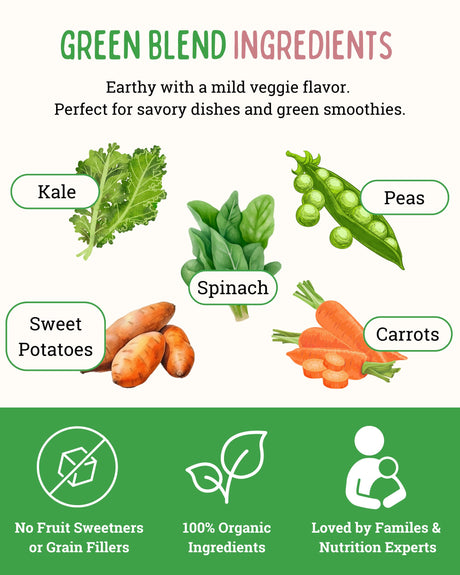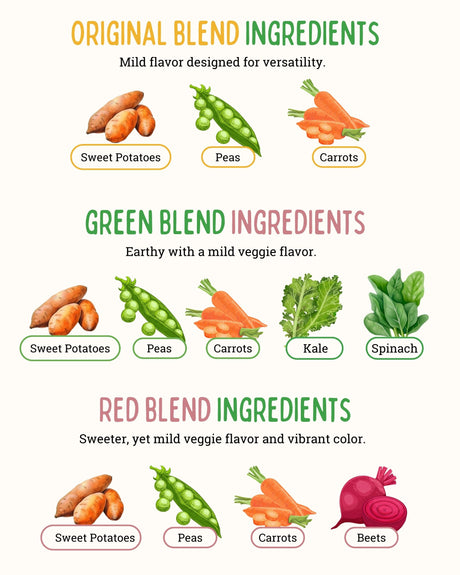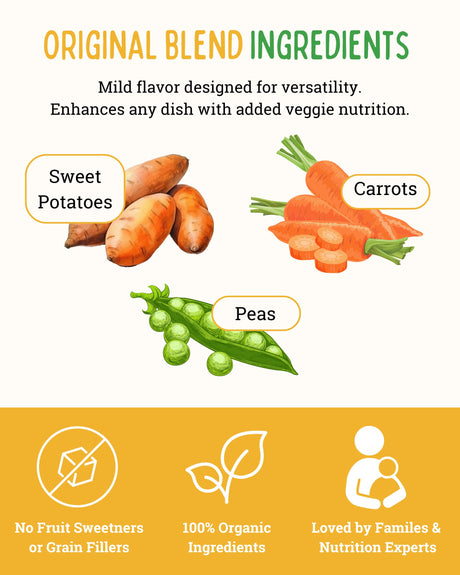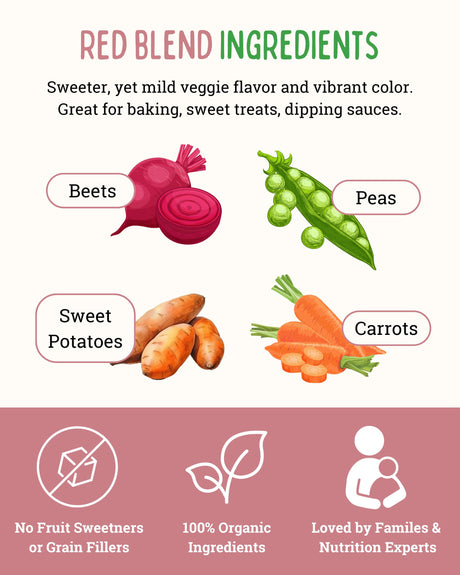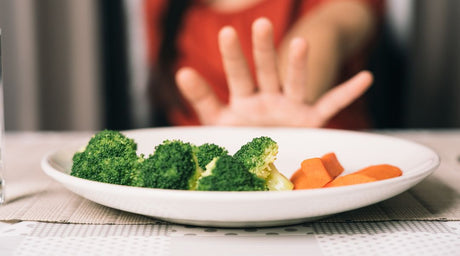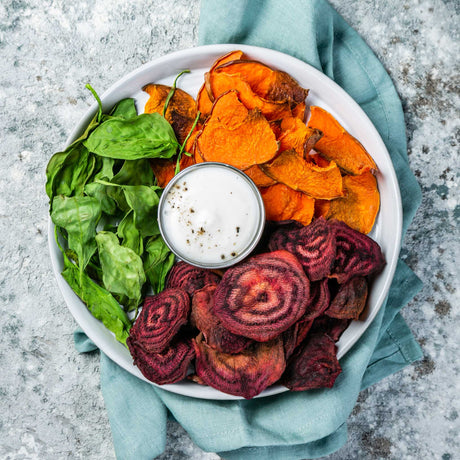Building Lifelong Healthy Eating Habits in Kids
In the whirlwind of parenthood, one of the greatest gifts you can give your child is a foundation of healthy eating habits. Instilling these habits early can set the stage for a lifetime of well-being. In this blog, we'll zoom in on the vibrant world of greens and the vital role they play in your child's diet.
The Importance of Instilling Healthy Eating Habits in Children
Right from the moment your child takes their first bite, you're crafting their relationship with food. Teaching them how to enjoy a variety of nutritious foods lays the groundwork for a healthier future.
By embracing this journey and introducing greens from an early age, you're nurturing habits that will support their growth and development.

The Focus on Incorporating Greens into a Child's Diet
Among the spectrum of healthy foods, greens are nutritional powerhouses. They're packed with vitamins, minerals, and antioxidants that bolster your child's immune system and promote healthy growth.
Learning to love greens is not just about getting them to eat their veggies; it's about equipping them with the tools to make nutritious choices throughout their lives.
Promoting Greens from an Early Age
Our goal is to guide you through this exciting culinary journey, offering insights, tips, and fun ideas to make greens a natural and enjoyable part of your child's diet. From understanding why greens matter to creative ways of incorporating them into meals, we'll explore every facet of nurturing a love for greens in your little one's heart and taste buds.
So, let's embark on this green adventure together!
Why Greens Matter
Nutritional Benefits of Leafy Greens for Children's Growth and Development
Leafy greens, like spinach, kale, and broccoli, are nature's multivitamins. They're teeming with essential nutrients that kids need for healthy growth. These greens are a superb source of vitamins A, C, and K, along with vital minerals like calcium, iron, and folate.
With all these nutrients packed into every bite, greens help children's bones grow strong, their immune systems stay robust, and their brains develop optimally. Plus, greens are loaded with fiber, which supports healthy digestion and helps your child feel fuller for longer.

The Role of Greens in Preventing Childhood Obesity and Related Health Issues
Childhood obesity has become a concerning epidemic, with long-term health repercussions. Greens are a valuable ally in the fight against this issue. Their low-calorie, nutrient-dense nature helps kids maintain a healthy weight while getting the essential nutrients they need. Encouraging greens in your child's diet early on can help prevent excessive weight gain, reduce the risk of developing chronic conditions like diabetes, and instill a love for healthy eating that they'll carry into adulthood. Greens are not just veggies; they're a recipe for long-term well-being.
Types of Kid-Friendly Greens
A Variety of Greens Suitable for Children, from Spinach to Kale
When it comes to introducing greens to your child's diet, there's a rainbow of options to choose from. Spinach is a mild and versatile choice, perfect for sneaking into smoothies or mixing into pasta dishes. Kale, despite its sturdy reputation, can be made kid-friendly when baked into crispy chips or finely chopped and added to soups.
Swiss chard, with its colorful stems and mild flavor, is a fantastic addition to omelets or stir-fries. And don't forget about romaine lettuce and butterhead lettuce, which make excellent bases for salads that kids can customize with their favorite toppings.
Highlighting Greens with Milder Flavors That Kids Are More Likely to Enjoy
While greens like arugula and mustard greens may be too peppery for young taste buds, there are plenty of mild options to try. Bibb lettuce, with its tender leaves and sweet flavor, is an excellent choice for salads or sandwiches.
Boston lettuce, often referred to as "butter lettuce," is another gentle green that kids tend to enjoy. It's named for its soft, buttery texture and mild taste, making it a hit in wraps or as a base for bite-sized appetizers. Experiment with various greens to find the ones your child likes best; you might be surprised by their preferences!
Fun Ways to Introduce Greens
Creative Recipes and Meal Ideas That Incorporate Greens

One of the keys to getting kids to embrace greens is by making them part of fun and delicious dishes. Try blending spinach or kale into a fruit smoothie – the vibrant color and sweet taste of fruits will mask the green goodness. Sneak finely chopped greens into spaghetti sauce or homemade pizza sauce for added nutrients without altering the taste.
Another clever way is to make green popsicles using spinach, yogurt, and a hint of honey; your child won't even realize they're enjoying a nutritious treat.
Strategies for Making Greens Visually Appealing and Tasty for Kids
Presentation matters, especially when it comes to enticing young eaters. Turn greens into a vibrant, colorful salad by adding cherry tomatoes, carrots, and sliced bell peppers. Encourage your child to build their salad by offering various toppings and a tasty dressing.
Create "green monsters" by arranging greens into funny faces on the plate with tomato slice eyes and carrot stick smiles. Incorporate greens into kid-friendly wraps or sandwiches, and roll them up for easy handling. The key is to make greens visually appealing and enjoyable, so your child is excited to dig in!
Setting a Positive Example
The Influence of Parents and Caregivers in Shaping a Child's Eating Habits
Parents and caregivers play a pivotal role in cultivating a child's relationship with food. Children are highly influenced by the behaviors they observe at home. When adults demonstrate enthusiasm for greens and healthy eating, kids are more likely to follow suit.
Make mealtime a positive and relaxed experience, allowing children to explore and enjoy different foods, including greens. Avoid using food as a reward or punishment, as this can create negative associations with certain items, including greens. Instead, focus on fostering a joyful and healthy attitude toward eating.
Role Modeling Healthy Greens Consumption
Children tend to mimic the eating habits of those around them, particularly their parents or primary caregivers. If you want your child to embrace greens, lead by example. Incorporate greens into your own meals and show genuine enjoyment while eating them.
Describe the flavors and textures to your child, making greens sound enticing. Sharing the experience of discovering new greens together can be an excellent bonding activity. Remember, your enthusiasm and positive attitude can go a long way in encouraging your child to develop a love for greens from an early age.
Growing Greens at Home
Starting a Small Garden or Container Garden with Kids

One effective way to nurture a love for greens in children is by involving them in the process of growing their own greens. Whether you have a spacious backyard or just a small balcony, there are options for starting a garden with your kids. Container gardens, raised beds, or even a few pots on a windowsill can provide ample space for cultivating greens.
Let your child choose the types of greens they'd like to grow, which can include spinach, lettuce, or herbs like basil or parsley. Gardening fosters a sense of responsibility and pride in nurturing plants from seed to harvest, making greens more appealing when they've had a hand in growing them.
The Educational Benefits of Involving Children in the Gardening Process
Gardening offers numerous educational opportunities for children. It allows them to connect with the natural world and learn about the life cycle of plants, soil health, and the importance of water and sunlight. As they watch their greens sprout and flourish, they gain a deeper appreciation for where food comes from.
Gardening can also stimulate curiosity, problem-solving skills, and creativity.
Encourage your child to ask questions, explore, and experiment in the garden. Additionally, it provides quality time spent outdoors, away from screens, promoting physical activity and a sense of accomplishment as they harvest their homegrown greens.
Overcoming Picky Eating Habits
Addressing Common Challenges When Kids Are Hesitant to Try Greens
It's not uncommon for children to be a bit wary of new and unfamiliar foods, including greens. The texture, color, or taste of leafy greens may pose a challenge for picky eaters. To address this, consider introducing greens in small, manageable portions.
Start by incorporating them into familiar dishes like smoothies, pasta sauces, or omelets. Gradually increase the amount of greens as your child becomes more accustomed to their presence. Also, be patient and persistent – it may take several attempts before your child develops a taste for greens. Keep in mind that children's taste preferences can change over time, so don't give up on offering greens even if they initially reject them.
Tips and Tactics for Encouraging a More Adventurous Palate
Encouraging adventurous eating habits in children can be a rewarding journey. One effective strategy is to involve them in meal planning and preparation. Let your child choose a green vegetable at the grocery store or farmers' market and discuss how to incorporate it into a meal. Get creative in the kitchen by trying out different recipes together, allowing your child to explore various cooking techniques and flavors.
Make mealtime an enjoyable experience by setting a positive atmosphere – turn off screens, have family conversations, and create a relaxed dining environment. Celebrate small victories and acknowledge your child's willingness to try new foods, even if they don't become instant fans of greens.
Balancing Greens in the Diet
Understanding Portion Sizes and Frequency of Green Consumption
When it comes to incorporating greens into your child's diet, it's crucial to strike a balance. While greens are incredibly nutritious, overloading them might not always be the best approach, especially if your child is new to these veggies. Pay attention to portion sizes that are appropriate for your child's age and appetite.
For younger children, a small serving of greens, such as 1/4 to 1/2 cup, a few times a week can be a great start. Older kids may consume larger portions, but moderation is key.
In terms of frequency, aim to include greens in your child's diet regularly, but not necessarily every day.
Variety is essential for a well-rounded diet, so rotate between different green options and incorporate them into various meals and snacks throughout the week. This approach helps prevent palate fatigue and ensures that your child enjoys a diverse range of nutrients.
Incorporating Greens into Various Meals and Snacks
Greens aren't limited to salads or side dishes – there are numerous ways to weave them into your child's daily meals and snacks. For breakfast, consider adding spinach or kale to smoothies, blending them with fruits and yogurt for a tasty morning treat.
Lunchtime opens up opportunities for wraps or sandwiches filled with lettuce or arugula. When it comes to snacks, kale chips or celery sticks with hummus can be delicious and nutritious options.
Dinner is an excellent time to get creative with greens, as they can be incorporated into pasta sauces, stir-fries, or even homemade pizzas. Experiment with different cooking methods, from sautéing and roasting to steaming, to find what your child enjoys most. By diversifying how greens are served, you can make them an exciting and integral part of your child's diet without them even realizing it.
Celebrating Green Milestones
Recognizing and Applauding a Child's Progress in Adopting Green-Eating Habits
As parents and caregivers, it's vital to recognize and celebrate the milestones your child reaches on their journey towards embracing greens. These milestones can be as simple as trying a new green vegetable for the first time or finishing their greens without any fuss. Celebrate these moments with enthusiasm and praise.
Tell your child how proud you are of their willingness to explore new flavors and the healthy choices they're making. Keep in mind that every child is different, and their progress might vary. Some kids may take to greens quickly, while others may need more time and encouragement. Celebrate even the smallest victories, and don't be discouraged by occasional setbacks.
The goal is to create a positive and nurturing environment around greens, making them an enjoyable part of your child's diet.
The Importance of Positive Reinforcement and Encouragement
Positive reinforcement goes a long way in helping children develop healthy eating habits, including their willingness to consume greens. Whenever your child willingly chooses greens or expresses a preference for them, provide positive feedback. This can include verbal praise, high-fives, or even a small reward like choosing a favorite activity.
Avoid using negative tactics, like forcing greens or making them a source of punishment, as these can create a negative association with these foods. Instead, focus on building a positive and supportive atmosphere that encourages your child to explore greens at their own pace. Celebrate their efforts, and soon, greens will become a cherished part of their diet that they enjoy without hesitation.
Fostering a Love for Greens in Children
Recap: Building Healthy Habits Involving Greens in Children
We've explored the importance of introducing greens to children from an early age. We've discussed the numerous nutritional benefits of greens, the types of kid-friendly greens available, creative ways to incorporate them into meals, and the influence parents and caregivers have in shaping children's eating habits.
We've also touched on the educational aspects of growing greens at home, overcoming picky eating habits, and balancing greens in the diet. All of these insights emphasize the value of greens in a child's diet and their role in promoting overall health and well-being.
Encouragement for Parents and Caregivers to Start Early and Stay Committed to Fostering a Love for Greens in Their Child's Diet
As parents and caregivers, your role in shaping your child's eating habits is pivotal. Starting early and consistently offering greens in various forms is a positive step toward helping your child develop a love for these nutritious foods. Remember to set a positive example, celebrate your child's progress, and create a nurturing environment around greens.
Keep in mind that each child is unique, and patience and encouragement are key in this journey.
By fostering a love for greens from an early age, you're not only helping your child build a foundation for a lifetime of healthy eating habits but also providing them with essential nutrients for their growth and development. So, start today, and watch your child embrace greens as a delicious and cherished part of their diet.
Leave your comments below; we love to hear from you! And don't forget to follow EasyPeasie for more veggie info and convo on YouTube, Facebook, and Instagram! ~ThePeas



